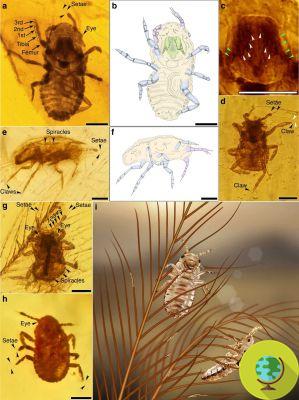The dinosaur feathers were chock full of lice. This is demonstrated by two amber fossils that contain tiny insects.
Even at the time of the Dinosaurs existed the lice and their feathers were full of them. This is demonstrated by two amber fossils re-analyzed by paleontologists at the Capital Normal University in Beijing, who noticed the presence of some tiny insects in two visibly damaged feathers of feathered dinosaurs.
The study, published in the scientific journal Nature Communications, talks about a louse called Mesophthirus engeli, where Mesophthirus literally means "Mesozoic louse", dating back to 100 millions of years ago, which adds to the long list of parasites that bothered dinosaurs, from fleas to ticks.
The insect probably measured about 0,5 mm in length and was more or less double the width of a human hair, a curious dimension for the time since the parasites were usually larger. But it could also be that they were very young lice, destined to grow into adulthood.
What is certain is that Mesophthirus engeli is now officially the oldest feather-chewing louse in history, even older than Megamenopon rasnitsyni, a 44 million-year-old louse found in a fossil in Germany.

Mesophthirus engeli had characteristics partly similar to the modern louse, even if the mouth was not as sophisticated and strange bristles were present on the claws and antennae. It did not fly, its head was dominated by strong jaws, antennae and legs were structured in such a way as to get stuck in the feathers and it mainly ate feathers and their remains, although researchers believe it did not bite the skin of dinosaurs, which is why these the latter probably did not even notice his presence.
An important discovery because it is very difficult to find ancient lice in amber in such good conditions, and fundamental for studying the relationship between ancient parasites and their hosts, obtaining valuable information on the evolution of parasites as we know them today.
You might also like:
- 4 new species of parasitic wasps perfectly preserved in their hosts for 40 million years (VIDEO)
- Fossil of this ancient marine creature found in the resin of a tree
- 10 spider fossils found that left researchers speechless (don't open if you suffer from arachnophobia)
Photo Credit: nature.com


























